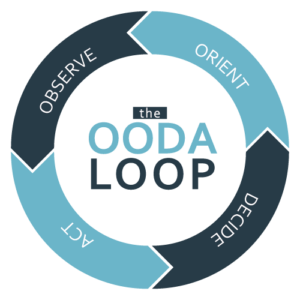4 Steps to Workplace Safety OODA Loop
The OODA Loop is a time-tested way to standardize the decision-making process in potentially hazardous situations to get consistent outcomes.

Workplace Safety is the result of consistent, excellent performance. A rehearsed method for staying safe is especially important when things get busy or loud. Rather than having to figure everything out on the fly, you can fall back on a pre-written process. The OODA Loop provides a quick and efficient way to look at the decision-making process.
Origins of the OODA Loop
Colonel John Boyd, United States Air Force – Retired developed The OODA Loop. This four-step process that was developed is an effective tool that improves situational awareness. It encourages consistent/thoughtful decisions and improves safety. While companies try their best to keep their employees safe through training and supervision, accidents do sometimes occur.
Especially serious accidents can happen in places like construction sites. While construction project management software and PPE like ear safety plugs and goggles are vital for maintaining a safe job site, a safe state of mind is also crucial.
Achieve the desired outcome through a continuous, conscious, and methodical approach to making informed decisions. Boyd’s briefings were originally intended for the United States Military Services. However, in the years since then, these ideas have traveled into the Business, Law, and Higher Education sectors. Consequently, the OODA Loop concept is applicable to many other aspects of our professional and personal lives.
Steps of the OODA Loop
The Loop provides immediate feedback throughout the decision-making process. The four steps of the OODA Loop are as follows.
- ( O) Observe – Reflects the need for situational awareness, detecting changes that are happening around us. Whether we are on the roof installing equipment, operating machinery in a factory, or simply driving to work, we need to continuously monitor our surroundings. Knowing what is happening and what may be coming, is the first step to being ready for it. Awareness of the situation and your surroundings provides us with a constant reference point, and the ability to apply the next step.
- ( O) Orient – Focuses attention on hazards, abnormal conditions, discrepancies, or challenges in our environment. Therefore the individual is aware of the situation or event at this time and can consider the available options. Looking at all these options is what allows us to make the right decision.
- ( D) Decide – Decide is where the individual makes a positive determination about a specific effect and chooses an option. As a result, the actor bases his/her decision on experience and knowledge of potential results. Consequently, they take a particular action that will produce the desired result.
- (A) Act – The physical input to achieve the desired result. The last step is also the action step. This is where the individual would jump out of the way of the falling item or extinguish a fire.
Consequently, once the loop is completed, the individual is once again in the Observe position. The person then adds the action assessment to the previously perceived aspects of his/her environment. Furthermore, he/she will be more prepared for the next time a similar incident occurs.
The Advantage of the OODA Loop
Finally, the biggest advantage of the OODA Loop model is that it is cumulative and allows for multiple progressions to occur. The OODA Loop builds with each new incident. As a rooftop contractor, the crew at Moffitt works together and pools their experiences. Combining these experiences, and working together, is what makes them a team.
Most of all, understand the OODA Loop and how it plays out in your head. Consider some common situations you encounter and think through the steps ahead of time. Remember, the next time someone says, “keep me in the loop”, think OODA Loop.
